|
| |
Yap
Ah Loy's Administration. As
Kapitan Cina, Yap Ah Loy had the powers of a typical
Malay chief, including the power of life and death over
his followers. He could make laws when deemed necessary,
but he did not have the right to collect tax.
He lived in good terms with the
Malay communities and their leaders in and around Kuala
Lumpur, of which the Dato' Dagang was the most important
of the chiefs.
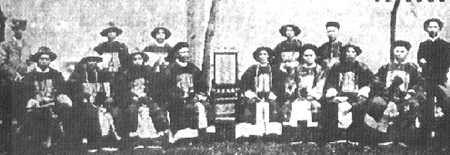
|
| Late
1890s, prominent Towkays of Kuala Lumpur with
Qing dynasty officials. Front row from right:
Loke Chow Kit, Chan Sow Lian, Loke Yew and Yap
Kwan Seng. |
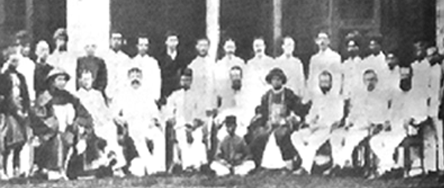
|
Group
photograph taken in Kuala Lumpur in 1884.
Front row (L to R): Yap Ah Shak, unidentified, Dr
Sinclair, Raja Laut, J.P. Rodger (British
Resident Selangor), Yap Ah Loy, unidentified,
Captain Syers (Police Chief, Selangor). |
Yap Ah Loy probably
administered through the leading Mine employers and clan
or secret society
headmen; usually the same individuals were both the
employers and the headmen. Yap Ah Loy's right-hand man
was Yap Ah Shak, who was now the head of the Hai San
society in Selangor and the largest mine owner after Yap
Ah Loy.
Yap Ah Loy acquired a reputation for
thoroughness in the treatment of criminals and other
troublemakers. He built a prison large enough to
accommodate 60 people, and drew up detailed rules for
punishing all offenders. These offenses were graded
carefully, with maximum penalties for repeat offenders.
For a first offense, a thief was paraded through the
streets with the stolen good tied to his back and
shoulders; for a second offense, an ear was cut off; and
for a third he was executed. The execution was not
performed by hanging or beheading, the offender was made
to kneel with his hands tied behind his back, and a sword
was plunged through his throat by the executioner. On the
other hand, minor offenders were more usually locked up
before their trial. The punishments seemed severe, but
they had a good effect on discouraging crime.
Yap Ah Loy's strict policies
proved to be successful. In the months following his
appointment, thieving became unknown. It was said that
"no man dared stoop to pick up even which he had
dropped on the road." Pirates no longer raided the
boats moving down the river and the loads of tin reached
the river mouth safely.As a result,
he effectively kept peace amongst 10,000 Chinese with
only a token force of six police.
Both Yap Ah Loy and Yap Ah Shak sat
as magistrates to in minor cases. It was said that they
acted as magistrates and mediated disputes amongst the
people at a corner of Yap Ah Loy's Chinese medicine shop,
Chop Tuck Sang. Until 1878, serious cases were tried in Klang, but between 1878 and 1880, the Resident and a
magistrate came to Kuala Lumpur monthly to hold the High
Court and the Magistrates' Court.
|
The Composition of Yap Ah Loy's
Administration
|
| Secretary and Business Affairs |
Chew Yeok |
| Justice Administrator |
Yap Ah Shak |
| Legal Adviser |
Wong Tian Chan |
| Military & Defense |
Chung Piang & Hiu Fatt |
| Foreign Affairs |
Voon Siew |
| Domestic Affairs |
Kok Fan Kui |
| Custom, Taxation & Revenue |
Wong Chi |
| Transport & Logistics |
Chee Kuan Tin |
| English Translator |
Moi Fa Chong |
| Malay Translator |
Che Ache |
Swettenham commented on Yap Ah Loy
as follows:
"As the confidence of his
countrymen in Capitan Ah Loy is great, if not implicit,
so is his stake in the country superior to that of all
others, and from this fact I conclude that the government
may rely upon him to use his influence for law and order,
and that his past loyalty and successful administration
of the District entrusted to him would seem to entitle
him to consideration and a careful hearing of his views
on matters affecting the well-being of the Chinese
population in general and in Kuala Lumpur in
particular."
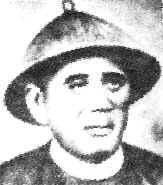 |
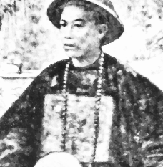 |
Yap
Ah Shak, successor to Yap Ah Loy. Kapitan Cina
from 1885-1889
|
Chew
Yeok, Yap Ah Loy's chief
assistant and in-law.
|
Yap Ah Loy's biggest
contribution to Kuala Lumpur was probably his success in
establishing Kuala Lumpur as the centre for commerce in Selangor. This success was to eventually compel the
Selangor Government to relocate the state capital from
Klang to Kuala Lumpur. In time, Kuala Lumpur was to
become the national capital for the newly independent
nation of Malaysia in 1957.
Yap Ah Loy was not ahead of his
times as a municipal administrator. In 1882, Swettenham
and his colleagues described the streets of Kuala Lumpur
as only 12 feet wide and were "all but impassable
alleys. ..... The filth of the market is
indescribable, everything that rots or becomes putrid,
all offal and refuse is thrown on to the ground or into
ditches which surround the shed. ..... The refuse of the
drains is simply removed therefrom and laid on the side
of the road ..... small pox, cholera and fevers break out
here very often."
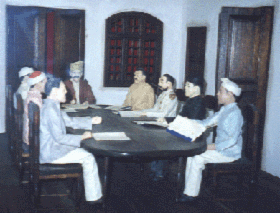 |
The
Meeting of the first Selangor State Council.
(from the Selangor
State Museum)
|
His fire precaution
consisted of an order that every household keep a barrel
full of water ready at all times. On 4 January 1881, the
entire town was burnt down, with a loss estimated at
$100,000 of which Yap Ah Loy's shouldered the largest
share of it.
After the disastrous fire of 1881,
Yap Ah Loy started a brickworks at the outskirts of town
to rebuild town buildings in brick or adobe with tile
roofs. The brickworks is now gone, but nevertheless had
left its mark with the an outskirt of today's Kuala
Lumpur known as Brickfields.
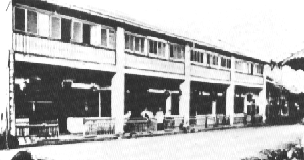
|
The
first row of brick shop houses in Kuala Lumpur,
on the edge of Market Square, built by Yap Ah Loy
in 1884.
|
Yap Ah Loy's road
construction in and around Kuala Lumpur were more
exemplary. The main mining areas were linked up with the
town, and streets were laid out in the town. Yap Ah Loy
told Swettenham that $20,000 had been devoted to road
works, in the more ambitious constructions, each mile of
road was estimated to cost $1,500. In return for these
projects, Yap Ah Loy was compensated with the permanent
titles to the land he occupied in the centre of Kuala
Lumpur.
 |
Junction
of Petaling Street and High Street.
|
The tracks to the
mines are preserved to this day in the form of Jalan Ampang, Jalan Pudu, Jalan Petaling and etc. The modern
passers-by who walk along these roads can be sure that
they are following the footsteps of heavily laden porters
who threaded these paths some 130 years ago.
Yap Ah Loy also started a tapioca
mill in Petaling Road with an imported 8 horsepower
engine. This venture in which Sultan Abdul Samad had a
$3,000 stake in the tapioca plantation, fell apart due to
the fall in price of tapioca during 1880. The present
Jalan Petaling (or Petaling Road as it was known then)
has remained to this day been known to local Chinese as Chee
Cheong Gai (or Tapioca Mill Road).
Yap Ah Loy also founded a refuge at
which the sick could have food and shelter. It was
maintained by a levy of $1 per pig slaughtered.
He took a big part in founding the
first Chinese school in Kuala Lumpur and provided the
school a schoolmaster until the Government brought in one
from Singapore. The school was opened on Chinese New Year
in 1884 in High Street. The Chinese towkays were known to
take an active interest in the school, by visiting the
school to test the pupils in reading and writing.
|





